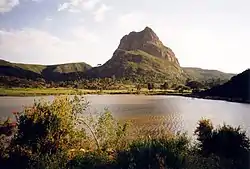Relief Society of Tigray
The Relief Society of Tigray (abbreviated REST, and known as Maret in Tigrinya) is an NGO based in Tigray, northern Ethiopia.[1]REST was founded in 1978 as an organization providing relief efforts to civilians.[2] As of 2008, Teklewoini Assefa served as Executive Director of REST.[2] REST emerged as the humanitarian wing of the Tigray People's Liberation Front (TPLF) and has remained closely linked to TPLF.[3][4] REST was active throughout the armed conflict of the 1980s, including during the devastating 1984-1985 famine.[2] Since the 1990s it is the major NGO operating in Tigray.

Emergence
During the war, working in the areas under the control of the TPLF, REST operated over 60 schools and 53 clinics. The organization had a literacy programme, which claimed to have educated 405,834 persons in the period of 1981 to 1983. REST also sought to provide clean drinking water in these areas.[5] Through TPLF resources from the Tigrayan diaspora in North America and Europe and different NGOs were channeled to Tigray.[6] In 1981 the Emergency Relief Desk was set up in Khartoum, as a consortium of Scandinavian ecumenical NGOs cooperating with REST and the Eritrean Relief Association (the humanitarian wing of the EPLF). The ERD provided food supplies to the Sudanese border, where it was picked up by REST and ERA to be distributed in Tigray and Eritrea.[7] In contrast Western governments avoided direct links with REST, continuing to channel aid efforts through the official mechanisms in cooperation with the Addis Ababa government.[6][7]
Famine
REST played a crucial role to undercut the Addis Ababa government's attempts to use famine as a means to obtain control over Tigray.[6] However, at the onset of the 1984-1985 famine REST suffered from logistical constraints. The organization had only 35 trucks, out of which many were in bad shape. Unable to cope with the humanitarian disaster, REST and TPLF decided to encourage Tigrayans to seek food at distribution centres operated by the Addis Ababa government.[8] The policy of encouraging movements to government feeding centres was reversed, as abuses were committed in those places. Now, people were asked to migrate towards western Tigray and onwards to Sudan.[9] Along the road REST organized distribution points for food, water and some degree of shelter.[9] The organization also provided rudimentary medical services were available.[9] Often REST would lead entire village groups into Sudan, were refugee camps were set up by the organization.[10]
Through its work during the famine, REST gained recognition amongst international NGOs. It also managed to change the attitude of the Sudanese government towards the resistance movements in Ethiopia (allowing the TPLF to operate, whilst ending support to the Ethiopian Democratic Union).[11]
Locusts
In the summer of 1987 Tigray was hit by a locust invasion, threatening crops. The organization lobbied, through its office in Khartoum, that the ICRC would send two helicopters to spray against locusts (an operation that eventually got the necessary go-ahead permission from the government in Addis Ababa). The locust problem again returned in 1988. REST also organized, along with TPLF, a volunteer force that would spray crops on the ground. A slogan was launched, "Fight the locusts with chemicals and the Derg with guns".[12]
Later period
After the end of the war and the fall of the Derg, REST worked with refugee repatriations. The organization signed treaties with the Transitional Government of Ethiopia and UNHCR for these activities.[13] REST provided humanitarian assistance for Tigrayan population during the 1998-2000 Ethiopian-Eritrean war.[3]
A 1996 document, circulated amongst diplomatic circles in Addis Ababa, alleged that REST (along with other organizations) channeled funds to the governing Ethiopian People's Revolutionary Democratic Front.[14]
In recent years, foreign government funding to REST has increased.[3] As of 2008, the Norwegian Development Fund was the largest donor to REST.[2] REST held its sixth General Assembly in 2008.[2]
Realisations

References
- Laura Hammond (2004), This Place Will Become Home: Refugee Repatriation to Ethiopia, Cornell University Press, p. 36, ISBN 0-8014-8939-3
- Royal Norwegian Embassy in Addis Ababa. Relief Society of Tigray celebrates 30th Anniversary
- Shinn, David H., and Thomas P. Ofcansky. Historical Dictionary of Ethiopia. Lanham, MD: Scarecrow Press, 2004. pp. 343-344
- Coote, Mike. Does Our Money Really Help?: Life in Ethiopia. Bloomington, Ind: AuthorHouse, 2007. p. 25
- Inquai, Solomon. Tigrai: The Agony and the Ecstasy. [Ethiopia?]: Printed by Berhanena Selam Printing Enterprises, 2007. pp. 76, 83
- Koonings, Kees. Political Armies: The Military and Nation Building in the Age of Democracy. New York: Zed Books, 2002. pp. 251-252
- Duffield, Mark. Development, Security and Unending War: Governing the World of Peoples. Cambridge [u.a.]: Polity Press, 2008. p. 73
- Inquai, Solomon. Tigrai: The Agony and the Ecstasy. [Ethiopia?]: Printed by Berhanena Selam Printing Enterprises, 2007. pp. 143-144
- Inquai, Solomon. Tigrai: The Agony and the Ecstasy. [Ethiopia?]: Printed by Berhanena Selam Printing Enterprises, 2007. pp. 64, 146-147
- Ashmore, Joseph, Jon Fowler, and James Kennedy. Shelter Projects, 2008. Nairobi, Kenya: UN HABITAT, 2008. p. 106
- Young, John. Peasant Revolution in Ethiopia: The Tigray People's Liberation Front, 1975-1991. Cambridge, U.K.: Cambridge University Press, 2006. p. 134
- Inquai, Solomon. Tigrai: The Agony and the Ecstasy. [Ethiopia?]: Printed by Berhanena Selam Printing Enterprises, 2007. pp. 127-129
- Hammond, Laura. This Place Will Become Home: Refugee Repatriation to Ethiopia. Ithaca: Cornell University Press, 2004. p. 191
- Merera Gudina. Ethiopia: From Autocracy to Revolutionary Democracy, 1960s-2011. Addis Ababa: [s.n.], 2011. pp. 113, 142
